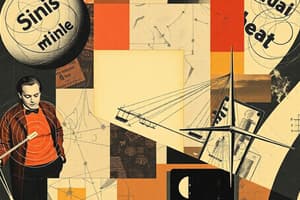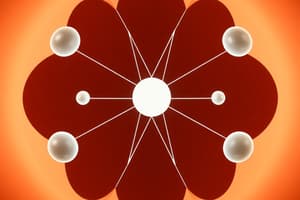Podcast
Questions and Answers
What is a set?
What is a set?
A well-defined collection of distinct objects.
How do we denote that an element belongs to a set?
How do we denote that an element belongs to a set?
Using the symbol Є.
Which symbol denotes a null or empty set?
Which symbol denotes a null or empty set?
- Ø
- ∅
- Both A and B (correct)
- { }
Order of elements in a set is important.
Order of elements in a set is important.
What is the cardinality of a set?
What is the cardinality of a set?
Which of the following is an example of a singleton set?
Which of the following is an example of a singleton set?
What is a universal set?
What is a universal set?
The empty set is a subset of every set.
The empty set is a subset of every set.
What defines two sets as equal?
What defines two sets as equal?
What is a power set?
What is a power set?
Match the types of sets with their definitions:
Match the types of sets with their definitions:
Flashcards are hidden until you start studying
Study Notes
Set Theory Overview
- A set is a well-defined collection of distinct objects, denoted by uppercase letters (e.g., S, A, B) and its elements by lowercase letters (e.g., a, b, c).
- Elements are enclosed in curly brackets: S = {2, 3, 4}. The membership of an element in a set is indicated by the symbol ∈ (e.g., 2 ∈ S).
- Important characteristics of sets:
- Existence of a rule for membership determination.
- Order of elements is irrelevant.
- Elements can represent quantitative or qualitative characteristics (e.g., C = {male, 64 inches}).
Methods of Representing Sets
- Tabular Form: Elements are listed within braces and separated by commas (e.g., A = {2, 4, 6, 8...}).
- Set-Builder Form: Represents large sets that cannot be listed conveniently, using properties to define elements (e.g., A = {x: x is an integer}).
Cardinality of a Set
- Cardinality indicates the number of elements in a set, denoted as n(S) or |S|.
- Example: For the set S = {2, 3, 4}, the cardinality is 3.
Types of Sets
- Null/Empty Set: Contains no elements, denoted by { } or Ø, with cardinality 0.
- Singleton Set: Contains a single element (e.g., {2}, {a}, {0}).
- Finite Set: Has a limited number of elements; the empty set Ø is finite.
- Infinite Set: Contains uncountable or infinite elements (e.g., the set of all positive integers).
- Universal Set: Contains all elements of interest in a study and all possible subsets.
- Subset: A set A is a subset of B (A ⊆ B) if all elements of A are also in B.
- Equal Sets: Two sets A and B are equal (A = B) if they contain exactly the same elements.
- Disjoint Sets: Two sets that share no common elements (e.g., A = {1, 2, 3} and B = {6, 8, 9}).
- Power Set: Collection of all subsets of a set, denoted P(A). For a set with n elements, the number of subsets is 2^n.
Properties of Sets
- The null set is a subset of all sets.
- Every set is a subset of itself.
- Union and intersection properties:
- A ∪ (B ∪ C) = (A ∪ B) ∪ C
- A ∩ (B ∩ C) = (A ∩ B) ∩ C
- A ∪ (B ∩ C) = (A ∪ B) ∩ (A ∪ C)
- A ∩ (B ∪ C) = (A ∩ B) ∪ (A ∩ C)
- A ∪ Ø = A
Venn Diagrams
- Venn diagrams visually represent sets and their relationships, including intersections and unions.
Studying That Suits You
Use AI to generate personalized quizzes and flashcards to suit your learning preferences.




